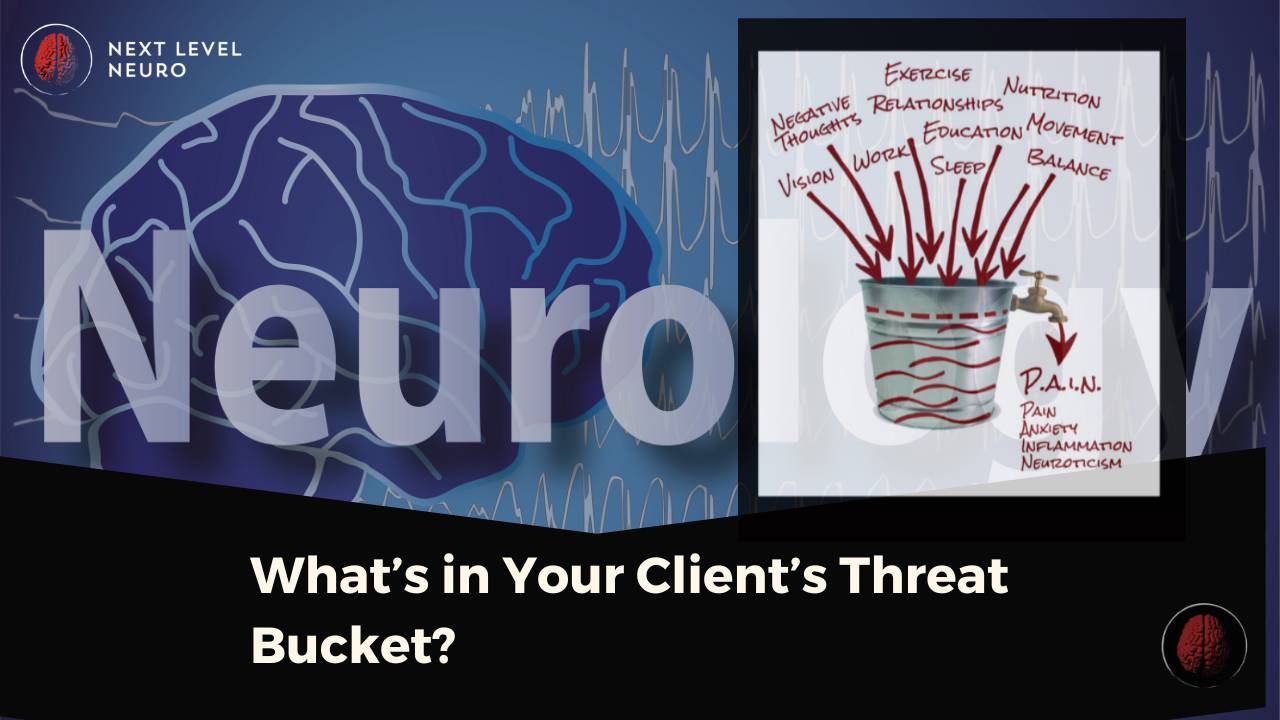The Threat Bucket: Why Your Clients Stall and What to Do About It
Oct 21, 2025
When Progress Stalls, the Brain Is Speaking
When a client stops progressing, most practitioners immediately tweak the plan.
Add mobility. Adjust a cue. Increase the load.
But what if the problem isn’t the program at all?
What if the brain is doing exactly what it’s designed to do — protect?
At Next Level Neuro, we teach a concept called the threat bucket. It’s one of the simplest, most transformative ideas you can learn about how the nervous system shapes performance, pain, and progress.
What the Threat Bucket Really Means
Every person has a metaphorical bucket inside their nervous system. Into that bucket goes everything the brain perceives as a potential threat: poor sleep, emotional stress, old injuries, visual or vestibular mismatch, inflammation, and even under-recovered training loads.
As that bucket fills, the brain starts shifting priorities.
Performance takes a back seat to protection. That protection can look like tight muscles, awkward coordination, fatigue, stiffness, or pain.
These symptoms aren’t signs of weakness or failure. They are protective outputs given by the nervous system as a way of saying, “I don’t feel safe.”
The Brain Doesn’t Separate Emotional from Physical Stress
Here’s the key that changes everything: the brain doesn’t separate emotional threat from physical threat.
It simply adds up the total load.
That means an argument with a partner, financial stress, or poor sleep can increase threat levels just as much as an ankle sprain or visual fatigue.
When the total load gets too high, the brain starts restricting movement and altering strength to keep you safe. This is why clients can feel “stuck” even when the structure looks fine on paper.
To the brain, safety always comes before performance.
When the Bucket Overflows
When the threat bucket overflows, the brain shifts into protection mode.
Pain, fatigue, poor coordination, and tightness are all ways it tries to reduce perceived risk.
It’s not punishing your client. It’s protecting them.
This is why traditional fixes often fall short. Most training or therapy models try to change the output. But the real change happens when we improve the input.
How to Help the Brain Feel Safe Again
This is where the Assess–Reassess process comes in. It gives you a way to test the nervous system’s response in real time.
-
Assess: Start by testing a simple, relevant movement or position. This gives you a baseline.
-
Intervene: Apply one targeted drill or sensory input based on your assessment, gait analysis, or visual screen.
-
Reassess: Test the exact same movement again. Did the range or quality improve? Did pain decrease?
If it did, the brain just told you, “That made me feel safer.”
It’s not magic. It’s the nervous system doing what it does best: adapting when safety improves.
If you want a Free Masterclass on this, click here.
It’s Not About More Drills, It’s About the Right One
When a client’s system is near capacity, adding more isn’t the answer.
They don’t need more drills. They need the right input for the right system at the right time.
The Assess–Reassess method helps you identify that quickly. It turns your sessions into a conversation with the brain and not a guessing game with the body.
From Protection to Progress
At NLN, we teach coaches, physios, and therapists how to read this feedback loop and respond in real time. When you can identify threat and reduce it, you unlock faster recovery, better movement, and immediate buy-in from your clients.
They don’t just feel improvement. They understand it. And that changes everything.
Learn to Read the Brain’s Signals
Want to learn how to spot hidden threats in your clients’ systems and reduce them in real time?
Join our free educational newsletter released on Saturday, and we will explore this specific topic in more depth.
https://www.nextlevelneuro.com/nln-newsletter-signup
We’ll show you how to assess, interpret, and influence the nervous system so your clients can move, perform, and heal more efficiently — starting the moment you begin.
If you would like to jump right in and get started with our Neuro dvantage Introductory Program for just 37$, you can do that here.
Want more information on our Mentorship and Programs?
We hate SPAM. We will never sell your information, for any reason.

